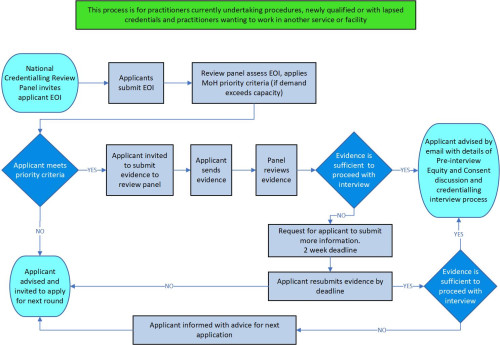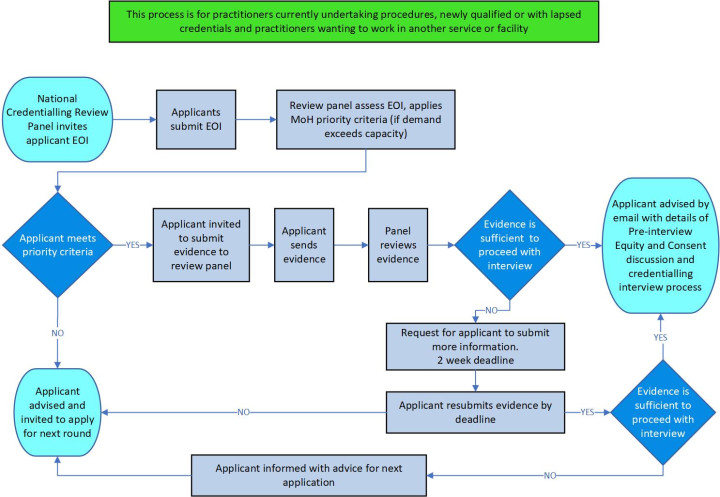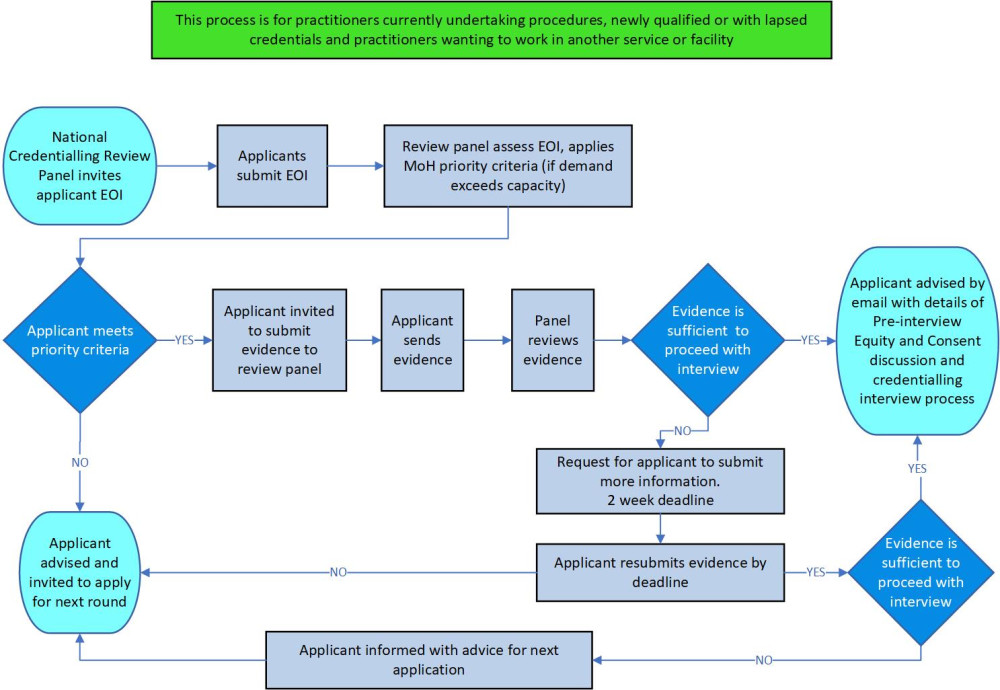On this page
Credentialling assigns clinical responsibilities to practitioners based on their qualifications and experience, with the primary goal of ensuring patient safety. It also protects practitioners, promotes accountability, and builds trust in the health system.
Credentialing in New Zealand is according to the New Zealand Credentialling Framework for mesh and non-mesh procedures for SUI and POP.
Read the New Zealand Credentialling Framework - Ministry of Health
Process
Information for surgeons accepted into the current surgical credentialling process for women’s stress incontinence and pelvic surgery procedures, including the use of mesh
Following completion of your Expression of Interest form, there is an assessment and prioritisation process.
View the Prioritisation tool (PDF 271KB)
This prioritisation process is designed to identify the surgeons who will progress to the next stage of the November credentialling round. This group of surgeons will be invited to provide a range of information to support their application. This will be followed by an online meeting with an equity representative and consumer advisor, followed by a face-to-face interview with an international panel of clinical experts. Interviews will be held in Auckland from 7 to 10 November 2024.
Is the Health NZ credentialling process different to the Ministry of Health process?
Health NZ became responsible for the credentialling process in July 2024. To maintain consistency, it is important that the credentialling process adheres to the Ministry of Health’s established procedures to maintain consistency across rounds and candidates. However, to enhance efficiency in the interview process and accommodate a larger number of candidates, some adjustments have been made to the sequence of events and the way in which you complete your paperwork. It is important to note that the evidence requirements remain unchanged.
What’s involved and what’s the timeframe for the process?
We will be in touch with the EOI applicants, by the end of August. At that time, we’ll provide details of what information and evidence needs to be provided for the next stage of the process.
Please note that if you submit incomplete information, you will be advised and given 14 days to provide the remaining information. Extensions will not be given. If you are unable to provide the outstanding information your application will not be progressed for this round and you will be advised.
Flowchart of the process



The flowchart provides a high-level overview of the process.
The flowchart above provides a high-level overview of the process.
Checklist for applications
Here’s a checklist of everything you need to prepare to support your application.
Templates and guidance for surgeons being credentialled
Information to be provided by credentialling candidates includes:
A completed Health NZ self-assessment form
A completed Health NZ self-assessment form
The self-assessment form is available here.
Personal audit (log book) information with self-analysis of what the data shows
Personal audit (log book) information with self-analysis of what the data shows
A sample template is available for your use.
*Note: if you use your own template, it must include all the fields included in this template. This information will include a diary of all relevant procedures you’ve carried out over the past five years.
Complications, complaints, compliments logbook
Complications, complaints, compliments logbook
Please use the template below to record details of all complications, complaints and compliments.
A reflective case study (anonymised)
A reflective case study (anonymised)
Further guidance on what the case study should cover is available with the template for the case study below.
Evidence of cultural safety and informed consent competence
Evidence of cultural safety and informed consent competence
Evidence of continuing professional education
Evidence of continuing professional education
Credentialling final assessment summary document to be used by assessors
Credentialling final assessment summary document to be used by assessors
This document illustrates all the standards you will be assessed against, and what the assessors will be looking for.
Credentialling final assessment summary document (PDF 462KB)
If you have any questions or would like clarification of any part of the process, please email meshcredentialling@cdhb.health.nz and someone will be in touch.
Importantly, please note that no patient names should be included in any of the information you submit. There are no exceptions.
If you submit information with patient identifiable information, it will be deleted and you will be advised to resubmit without identifiable information. Note this counts towards the 14 day deadline to resubmit.
Frequently asked questions about the credentialling process
What is the timeframe for the credentialling process?
What is the timeframe for the credentialling process?
For this current process, the 15 selected surgeons, along with a small group of surgeons on a short list will be advised of the pre-interview discussion process and invited to schedule a date and time for an in person interview. Candidates will have from the date of notification until close of business on 9 of October to submit all the required information. Interviews will take place in Auckland from 7 -10 November.
Who will arrange and pay for my travel, and any accommodation in Auckland?
Who will arrange and pay for my travel, and any accommodation in Auckland?
All candidates are required to cover their own travel related expenses. Those with CME may consider utilising this option.
When will the next round of credentialling be?
When will the next round of credentialling be?
There will be further credentialling rounds held in 2025. Dates will be publicised as soon as possible next year to allow surgeons to complete the initial Expression of Interest document.
Why are there only 15 places for surgeons to be credentialled when the demand is high?
Why are there only 15 places for surgeons to be credentialled when the demand is high?
Fifteen is an increase on previous cohorts. The cost of running the process, including securing international experts and consumers, and the administration of the process is time consuming, with a finite resource managing the process.
The initial prioritisation process is designed to ensure we have a good geographical spread of credentialled surgeons who can provide a range of procedures.
Health NZ used an updated version of the Prioritisation Tool originally developed by Manatu Hauora, the Ministry of Health.
What are the procedures surgeons can apply to be credentialled to perform?
What are the procedures surgeons can apply to be credentialled to perform?
Surgeons can apply for any number of procedures that they regularly perform and have evidence that meets the credentialling criteria.
Procedures have been categorised into three Tiers, based on complexity, as per the table below. This round is only inviting applications for Tier 1 and 2.
How many you apply for is unique to you, for example in the past people have applied to be credentialled to perform a couple of procedures in one Tier only, while others apply to perform most of the procedures in a number of Tiers.
You can find out more about what procedures you can apply for in the New Zealand National Credentialling Framework.
Read the New Zealand Credentialling Framework - Ministry of Health
Can we keep performing women’s pelvic surgery if we’re following the Australian Commission’s Guidelines?
Can we keep performing women’s pelvic surgery if we’re following the Australian Commission’s Guidelines?
Yes, you can continue using the Australian Commission’s guidelines for the procedures included in their guidance until there is an announcement by the Ministry of Health to advise otherwise.
What about the procedures not covered in the Australian guidelines?
All other non-mesh SUI procedures, and mesh and non-mesh POP procedures are not covered in the Australian Commission document. These are covered in New Zealand’s national credentialling framework.
Read the New Zealand National Credentialling Framework - Ministry of Health
Can credentialled surgeons provide these surgical procedures in the public and private health systems?
Can credentialled surgeons provide these surgical procedures in the public and private health systems?
Yes, we expect that many of the surgeons who will be credentialled will work in both the public and private systems.
When will I get my result from the credentialling interview?
When will I get my result from the credentialling interview?
We are aiming to have the provisional results out to candidates within four to six weeks of their interview.
Information about the appeals process will be uploaded up to this site in the coming weeks.
What does that mean? A glossary of credentialling terms
What does that mean? A glossary of credentialling terms
This glossary explains some of the terms used throughout the credentialling process, including the following: Invigilate, mentor, preceptor, proctor, proctoring.
Appeals Process
Appeals and reconsideration process
Credentialling for pelvic floor reconstructive, urogynaecological and mesh revision and removal procedures.
In the event a practitioner and their employer do not agree with the outcomes of the process to credential them for the prescribed pelvic floor reconstructive, urogynaecological and mesh revision and removal procedures, the following outlines a process by which that outcome can be appealed and submitted for reconsideration.
This must be done within 4-weeks of receiving your provisional outcome results.
The process to appeal or to request an adjustment of fact is outlined below.
Adjustment of fact
Where the practitioner believes a piece of evidence was originally provided but has been noted as missing in the provisional report or evidence that was provided but does not appear to be accurately represented in the provisional report, you may apply for an adjustment of fact.
To do so, email meshcredentialling@cdhb.health.nz clearly outlining the statement for adjustment with the supporting evidence for a review by the existing panel.
Appealing the decision of the credentialling panel
If the practitioner does not agree with the outcome of the reconsideration, an appeal can be made to Health New Zealand | Te Whatu Ora for review.
The practitioner should resubmit their application to meshcredentialling@cdhb.health.nz with evidence that addresses why they are appealing the original decision by their credentialling panel, and the reconsideration.
Health New Zealand | Te Whatu Ora will not accept an appeal that is made without effort to address the reason why they are appealing the panel’s decisions. An appeal panel will be convened to consider the appeal.
Members of the credentialling panel involved in the original decision will be excluded from the appeal panel.
The outcomes of the appeal will be:
- that the appeal panel agrees with the decision of the original panel; or
- that the appeal panel upholds the decision of the original panel, but invites the practitioner to resubmit after an agreed time period with conditions met; or
- that the appeals panel disagrees with the original panel and recommends the practitioner is credentialled. The recommendation would be made to Health New Zealand | Te Whatu Ora Credentialling panel Chair and Credentialling Committee Chair.
The practitioner will be notified of the outcome of the appeal process.
Updates
More details on 2025 credentialing opportunities will be available here in the New Year.